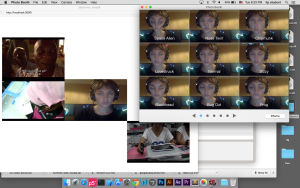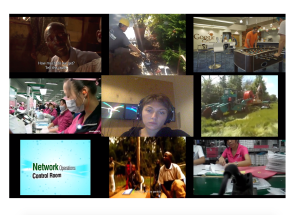ICM, Wk 8: Vid/Sound
This week, I wanted to continue visualizing these “ethereal” elements of technology.
I’ve been thinking a lot about how technology takes us out of the present, almost like it transports us into another realm. Using our phones, we’re in a sort of liminal space where our bodies are present but our minds are elsewhere…
Like I mentioned last week, it’s as if we’ve gone a step further from Marx’s object fetishism and alienation – now we even forget that we’re holding a physical object in our hand. How is our relationship with technology further distancing us from or creating an atmosphere of denial when it comes to thinking about the labor and the people it took to create this specific experience? The resources?
I went to the Radical Networks Conference this weekend and left feeling super inspired. A lot of people are playing with these questions of how do we visualize/materialize these unseen technological forces – from wifi and bandwidth, to cloud computing. One thing I DIDN’T get to, which I wish I had was Shuli Hallak’s talk on “Seeing the Internet.” From the program description:
“The power of the Internet is derived from its intangible, invisible properties. The ability of information to scale and traverse in an instant is transformative, and the application of that power can be used in multiple ways, some good and some not so good. Because we can not see these systems that we rely on — the hardware (routers, switches, data centers, fiber cables), and invisible properties (spectrum, wireless networks, protocol) — we are as a whole, left in the dark and unaware of how our own data exists in these networks. We often take a breath and hope the entities that we are “agreeing” with (“trusting”) will do good. And we are presented with less than desirable options: convenience or privacy, but we can’t have both. Really though, if we can’t see it, we can’t fully trust it.”
When I was an undergraduate (as well in my professional practice), I was always interested in the concept and systems of power. I think there is a lot of mystique that imbues the internet and other recent technologies with an aura of power (re: Walter Benjamin, yo). Humans have often assigned mystical powers to those things they don’t fully understand, and how many times at ITP have we talked about it being a “magical” place?
Now, it’s not like I’m trying to totally erase that sense of wonderment, but I do think we need to be more critical and informed about these systems because in reality, they are built and sustained by other humans – and as can be seen in this piece, often those without access to power and really don’t derive any power (political, economical and otherwise) from their participation in this labor system, i.e. making the internet.
——————————-
Last week, Dana suggested including people’s faces in my data center sketch to further illustrate the presence of the human element. So with that in mind, I thought this week I’d run with that as a concept. My idea was to feature a “brady bunch” -esque composition of the cast of people who help bring you the internet: miners from the Congo, Foxconn workers in China who assemble devices, construction workers who lay fiber optic cables, people in data centers, etc. Then, in the center would be…the user.
My intention with this sketch as that we get a glimpse at the people who are behind bringing us the internet and think about what our (moral? ethical?) relationship is to them and that while we may feel detached from the physical world while we engage with our phones, there are real political and economical forces at play.
One interesting thing I realized as I was putting it all together (and have casually realized) is how uncomfortable many people feel when they see themselves on screen. Often, they want to look anywhere else but their own face. This unease works to the benefit of the sketch, where the point is to look at the faces of others and consider them in relation to yourself.
Also – I found the secretive nature of these locations, jobs and forms of labor to be really interesting. It was more difficult than I expected it would be to find usable videos. Documentarians not allowed to film at mines, journalists getting “exclusives” from Foxconn, and even the videos of people laying fiber optics obscures the faces or don’t show them at all. Sometimes, in the case of data centers, they just don’t seem interested in the human component, rather the power of the machinery.
——————
My biggest issue in putting the sketch together was editing and compressing the videos. Originally, I wanted them to each play for a longer time – but I realized that would have made for huge files that probably would take forever to load. Even after editing and re-sizing, the sketch is still super slow to load. I think I’ll have to play with video export settings some more.
I realized as I was playing with the idea that the structure mimics the iOS Photobooth App…which, I liked as an additional visual metaphor.
(It did make me think that I could do a further iteration where the people are removed and replaced with a static background image representative of the different physical locations and then use createCapture() to overlay an image of the user in these places.)

